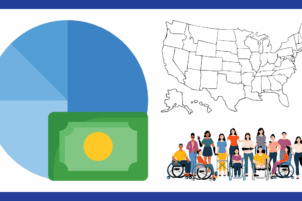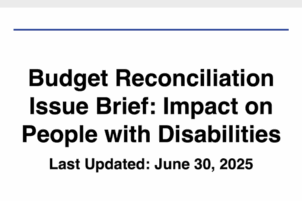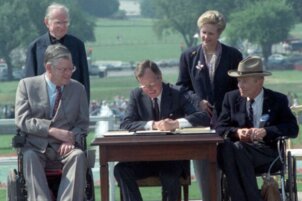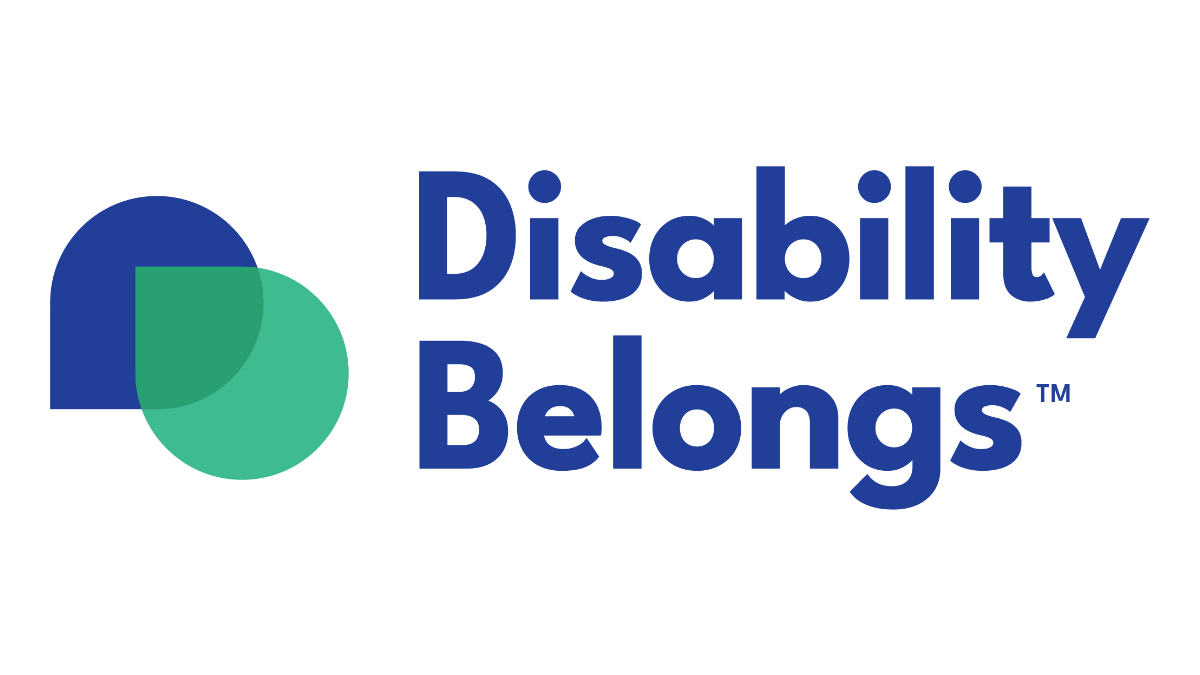Los Angeles, California, July 9 – American actress and former Miss Deaf America Lauren Ridloff is known for her 2018 Tony-nominated Broadway performance as Sarah Norman in Children of a Lesser God, and as Connie in the AMC Television series The Walking Dead. Recently she appeared on NBC’s New Amsterdam as Margot, a black, deaf LGBT patient who recently received a cochlear implant. Ridloff called the storyline “unique” in an interview with RespectAbility. She said it is “so surprising to see this play out on a television hospital drama.” Ultimately, Margot “regains” her deafness after deciding to have the cochlear implant removed.
“I was concerned about playing a person with a CI because I do not have CIs myself,” Ridloff said. “I reached out to three friends who are “Deaf” and have CIs to make sure that they felt that this portrayal was fair. One wished I wouldn’t take this role. One thought I was a great choice. And the other friend who is a fellow actor also understood the stakes of playing someone outside of my realm.”
“There are so many people who are perfectly happy with their CIs,” she added. “There are also many people who identify themselves as capital “Deaf” (meaning culturally and proudly deaf) and have gone under the knife for a CI, either out of sheer curiosity or for enhancement of what they already have. And they’ve stopped using their CIs because it did not meet their expectations. This episode just adds another layer to the whole Deaf narrative.”
In addition, this storyline in New Amsterdam showcases diverse racial, gender and sexual orientations with disabilities on television, something that is often not done.
“It is so important to showcase people with disabilities with intersectional identities because that allows viewers to see beyond disability,” Ridloff said. “People with disabilities are multilayered—we are complex breathing human beings defined by more than just what we lack.”
Read the full interview below:
Q: You have had quite a whirlwind year – after performing on Broadway to critical acclaim and earning a Tony nomination, you soon found yourself cast in one of the hottest shows on television, The Walking Dead. As a deaf actress, can you tell us a little bit about your experience in breaking into an industry and working with professionals that may have had little to no experience with deaf actors and in writing deaf characters?
A: Prior to my Broadway debut, I did not have much acting experience, so I had a very steep learning curve. I had to learn, first and foremost, how to act. And I’m still learning! On Broadway I was able to piggyback on other deaf actors who were in the same production as me, so through them I learned what I could push for in terms of accessibility, and when to lean back and consider it a small step in the grand scheme of things. But then when I started work in television, that was a new ballgame and I was mostly on my own. I had to learn how to work the camera, what kind of working relationship I wanted with the creative team, the crew and my castmates. And I had to navigate the fast-paced world of television and accessibility—each day presented something different, so I had to learn on my own what my specific television actor needs were. What I learned is that this kind of endeavor, incorporating an underrepresented person into the storyline, requires collaboration. When effective collaboration happens, everybody is learning and moving forward together. I am grateful that the professionals I’ve worked with up to this point have shown so much open mindedness and willingness to engage in dialogue in this unfamiliar space in order to tell a story.
Q: What message would you like to send to producers, writers and directors about creating stories with deaf characters, or working with deaf actors?
A: When I first joined The Walking Dead, I went out for dinner with some of the creatives during shooting and through our interaction, they discovered new things that they eventually incorporated into their storyline. So, engagement and conversation with deaf actors is key to bringing authenticity to the screen.
Q: Much of the creative work goes on behind the camera – writing, producing, filming and in actors preparing to perform in scenes – how important is it for deaf people to be involved in the creative process and in the preparation work that goes on behind the camera?
A: I’m shaking my head. It’s common sense. There is a plethora of information (literature, film, education, etc.) on the medical view of the deaf individual. That’s easy to google up and easy to regurgitate onto a piece of paper (or on a blank page on the computer screen) … but that does not make for interesting, emotional storytelling. People would not be drawn in. We are always looking for that touch of humanity when we hear stories. Stories exist to carry history, impart values and core beliefs and of course to entertain. So, what we need is realness. Having a deaf person involved with the creative process makes so much sense—the creative team would be enriched by that person’s experiences…it’d make the creating part much less problematic and much more efficient and interesting. And even if the story that comes out is not the best, what ultimately matters is that the storytellers come out with a better, wider viewpoint of the world.
Q: We do a lot of work with Hollywood in encouraging best practices in disability representation and inclusion. Can you tell us about the role that ASL dialogue coaches, sometimes described as “ASL Masters,” have in preparing actors for their dramatic performance of ASL dialogue from scripts that are generally written in the English language? Why is this important? What should producers look for in hiring ASL coaches/masters or consultants?
A: Because there are usually no deaf people involved with the writing process, the dialogue is often awkward when translated into ASL. Writers often write lines thinking that it’d look phenomenal signed, but with cultural implications those lines would be altered so much that the line, when signed, no longer makes sense. So that’s where an ASL master comes in. The ASL master works with the writer/director to find a happy medium (there has to be some leeway with the translation). An ASL master also checks on appropriate depiction of cultural mores, such as the different ways to get a deaf person’s attention and so forth. They also work with hearing actors who do not know sign language to ensure that the actors execute signs with the appropriate degree of fluency. Deaf actors are often able to translate their own lines, but the ASL Master provides a sounding board in the same sense that a director specifies certain inflections and emotions from a speaking actor. I feel that often ASL masters are hired with the idea that it’s FOR the deaf actor, but it’s more for the people around the deaf actor.
Q: Tell us about Margot – How did you prepare for this role? In playing this character, what thoughts or observations did you reach about who she is as a person? What drives her?
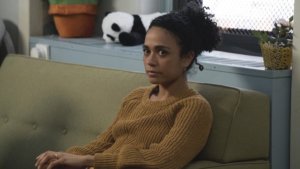
Lauren Ridloff as Margot. Photo Credit: Virginia Sherwood/NBC
A: I kept on thinking about Steve Jobs’ famous “Stay hungry, stay foolish” line when preparing for Margot. I imagined her as a person who is unafraid of testing boundaries and making mistakes. She explores and experiments, always living outside of the comfortable norm as a Deaf LGBT WOC who is in a mixed relationship. She’s colorful and hungry and curious and compassionate but we meet Margot at her lowest point. She tries to see what it’s like to live like the norm. I was concerned about playing a person with a CI because I do not have CIs myself. I reached out to three friends who are “D”eaf and have CIs to make sure that they felt that this portrayal was fair. One wished I wouldn’t take this role. One thought I was a great choice. And the other friend who is a fellow actor also understood the stakes of playing someone outside of my realm. I checked in with them for accuracy. For instance in the scene when Margot is sitting outside experiencing aural overload, I wondered what CI recipients would do with their hands—covering their ears seemed silly because the sounds are not “heard” through the ears but felt in the brain. My friend explained that in the beginning after her initial tune-up, she’d hold her head. Another said she’d just take the magnet off, but after conversing with the director, we chose to go for the head holding for more dramatic impact.
Q: Cochlear Implants are sometimes framed as a binary choice between choosing “deaf culture” and the “hearing world,” but in this story, your character dispels that notion – Margot made a choice to get a cochlear implant as a person who is both comfortable in her own skin as a deaf woman, and is in a loving relationship with Tori, a woman that lives in a hearing world. Can you tell us a little bit about this and what your thoughts are on Margot and her journey?
A: I loved this storyline! So unique, so surprising to see this play out on a television hospital drama. We are accustomed to seeing those inspirational porn videos on Youtube where a person who has been implanted “hears” for the first time and just lights up. In this episode we see Margot who “regains” her deafness and lights up at the end…this is the flip side of what has been the narrative for so long. This is also real. There are so many people who are perfectly happy with their CIs. There are also many people who identify themselves as capital “Deaf” (meaning culturally and proudly deaf) and have gone under the knife for a CI, either out of sheer curiosity or for enhancement of what they already have. And they’ve stopped using their CIs because it did not meet their expectations. This episode just adds another layer to the whole Deaf narrative. One of my favorite scenes is when Margot talks about having her thoughts to herself and music being purely sensory. That’s such a real moment. I feel that way whenever I wear my aids—they do have some benefits but there are times when I experience sensory overload and cannot think straight or find pleasure in the simpler things. In that sense I feel lucky that I can just literally “turn it off.”
Q: In this episode, Margot encounters medical professionals, such as Dr. Kapoor and Iggy, who come from a world of sound. This informs their worldview and makes it difficult for them to understand Margot’s experiences and ultimate decisions, whose life experience has been largely visual. What are your thoughts on their struggle to understand and eventually accept Margot’s choices?
A: I don’t think they completely grasp Margot’s joy at finding her deafness again but that’s not the most important point of the story. Iggy and Dr. Kapoor finally learn about Margot’s decision to alter herself for someone else, which is a very bad idea. They understand that Margot has an epiphany that she made a major life change to please someone else who did not need that change to begin with. We know that if we want to make drastic life changes, it is best if those decisions are rooted in self-love and self-acceptance. Margot’s choice to get the implant for someone else’s approval has altered her basic inner being and as a result she is unable to live honestly. That’s what I feel the doctors understand.
Q: Margot is a black, deaf LGBT woman. All too often people with disabilities are shown as white, straight men. Why is it so important to showcase people of diverse racial, gender and sexual orientations with disabilities on television?
A: It is so important to showcase people with disabilities with intersectional identities because that allows viewers to see beyond disability. People with disabilities are multilayered—we are complex breathing human beings defined by more than just what we lack.
Q: Looking to the future, any types of roles or genres that you are particularly interested in?
A: I currently am involved with a couple of very exciting and empowering projects, so right now that’s what I’m looking forward to. I wouldn’t object if Broadway came knocking again…
New Amsterdam has been renewed for Season Two and Season One, including this episode, “Happy Place” (April 23, 2019), can be viewed online now.


